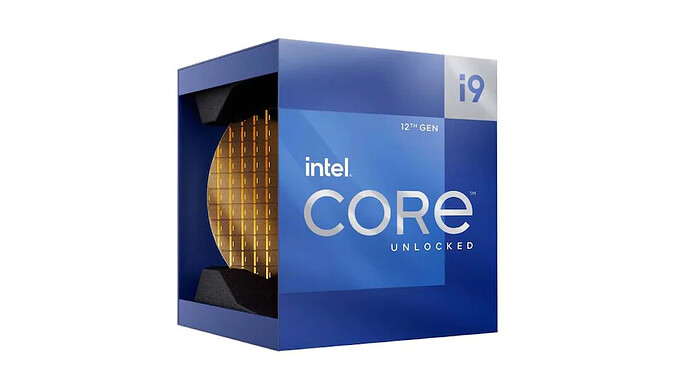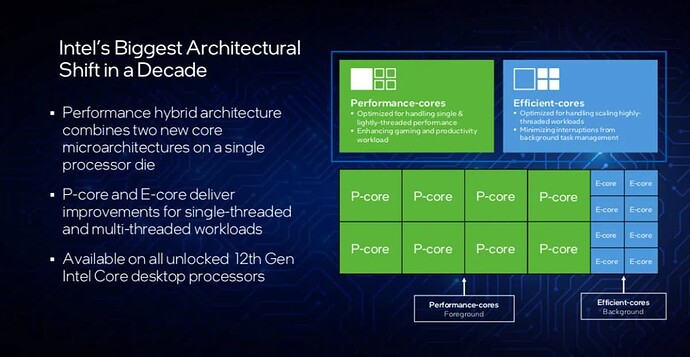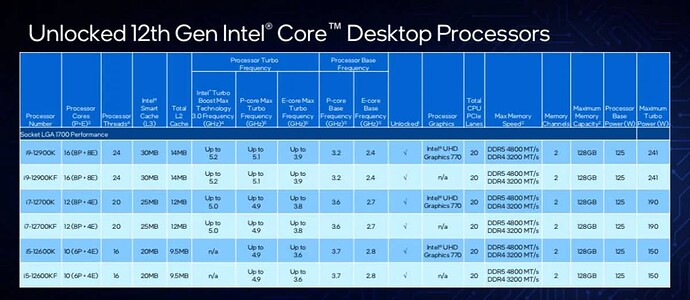Intel ‘Alder Lake’ 12th Gen Core i9, Core i7, and Core i5 CPUs for gaming, workstation and enthusiast desktop PCs have been launched, following several months of teasers and architecture-level disclosures. Six new models have been launched, all of which are unlocked and overclockable. These new CPUs are the first of the ‘Alder Lake’ family, and introduce a mix of heterogenous Performance and Efficiency cores for the first time in consumer X86 PCs. This also marks the advent of DDR5 RAM and the PCIe 5.0 interconnect standard. Intel has not yet announced the availability of 12th Gen CPUs for other segments such as laptops, however the company has said that additional desktop CPU models will follow in early 2022.
New 12th Gen ‘Alder Lake’ CPUs will have a mix of two different core types, which Intel is calling ‘Performance Hybrid Architecture’. This works in much the same way that ARM-based smartphone processors have been developed for several years now. This single architecture will serve all Intel’s consumer CPU categories, with different mixes of cores types. All 12th Gen Core CPUs will be manufactured on the newly renamed 10m ‘Intel 7’ process.
Prices in the US range from $589 (approximately Rs. 43,380 before taxes) for the top-end Core i9-12900K to $264 (approximately Rs. 19,445 before taxes) for the Core i5-12600KF. Models without graphics capabilities are priced slightly lower than their counterparts with integrated GPUs. These are prices per 1000 units, and might not reflect retail prices. Intel has said it expects robust retail availability despite the global semiconductor shortage, and multiple PC OEMs are also on board to ship pre-built desktops. Official prices in India are yet to be confirmed but some retail listings without prices appeared online as early as last week.
The new ‘Golden Cove’ Performance (P) cores succeed the ‘Willow Cove’ cores in the current ‘Tiger Lake’ architecture, while the ‘Gracemont’ Efficiency (E) core architecture can be considered a descendant of the erstwhile Intel Atom CPU range. Intel’s first hybrid CPU, codenamed ‘Lakefield’, was launched in 2020 but has been seen in very fewactual shipping devices. The 12th Gen desktop Core i9 CPUs announced so far feature 16 cores (8 P + 8 E), while Core i7 models get 12 cores (8 P + 4 E) and Core i5 models have 10 cores (6 P + 4 E).
While P cores are intended to handle high-impact lightly threaded workloads, background tasks and more multi-threaded tasks can be delegated to E cores. Also, P cores continue to benefit from Hyper-Threading, allowing two threads to run simultaneously, but E cores do not, so 12th Gen Core CPUs will have non-linear core/thread counts. To balance workloads and ensure that the optimal tasks are assigned to each type of core, Intel has developed a new dynamic scheduler that it calls Thread Director. This requires Windows 11, and Intel says that performance will not be as optimised on Windows 10 or other operating systems. Thread Director will first favour the P cores, then the E cores, and only once those are saturated will threads be assigned to the Hyper-Threading capacity of the P cores.
Each P core has its own L2 cache, while clusters of four E cores share their L2 caches. These feed in to a common L3 cache, allowing for quick transfers of data and low latency in workloads optimal for each core type. CPUs without the -F suffix will also feature integrated Intel UHD 770 graphics, based on the Xe LP architecture.
The new Z690 platform controller has been introduced, and 12th Gen Core desktop CPUs use a new, larger LGA1700 socket. Platform-level features for this generation include the first use of DDR5 RAM, with official support going up to 128GB (dual-channel) at 4800MT/s wit h XMP 3.0 profiles. DDR4-3200 RAM is also supported, and motherboard manufacturers will decide which standard to go with on each model. Alder Lake CPUs support up to 16 lanes of PCIe 5.0, doubling the bandwidth of PCIe 4.0. New CPU and RAM overclocking controls have also been introduced.
The Core i9-1200K is described as “the world’s best gaming processor” and Intel says it delivers significant gains in gaming as well as content creation workloads compared to the octa-core Core i9-11900K. It can run at up to 5.2GHz. The two different core types run at different Base and Turbo speeds: 2.4-3.9GHz for the E cores and 3.2-5.1GHz for the P cores. Base and peak power ratings are 125W and 241W respectively.
Intel claims 19 percent gen-on-gen performance improvements for the P cores. The Core i9-12900K is said to deliver 50 percent higher multi-threaded performance than the Core i9-11900K at a slightly lower 241W peak power consumption compared to 250W. At the rated 125W stock TDP, performance is up to 30 percent better, while the same level of performance can be achieved within a 65W power limit. When gaming and streaming simultaneously, Intel claims up to 84 percent better frame rates. When exporting edited video while processing RAW images, that figure is said to be 47 percent. Even running these tasks sequentially rather than simultaneously is said to be faster.
The rest of the lineup includes the Core i9-12900KF with nearly identical specifications; as well as the Core i7-12700K, Core i7-12700KF, Core i5-12600K, and Core i5-12600KF. The -F suffix indicates a lack of integrated graphics capabilities, while the -K suffix indicates that these are all unlocked and overclockable models. Lower-end versions of these CPUs should be launched in Q1 next year, potentially as early as CES 2022.
Source:Gadget360


